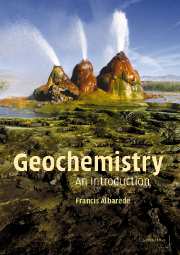Book contents
- Frontmatter
- Contents
- Foreword to the English edition
- Foreword to the French edition
- Acknowledgments
- Introduction
- 1 The properties of elements
- 2 Mass conservation – elemental and isotopic fractionation
- 3 Geochronology and radiogenic tracers
- 4 Element transport
- 5 Geochemical systems
- 6 Waters present and past
- 7 Mineral reactions
- 8 The solid Earth
- 9 The Earth in the Solar System
- 10 The geochemical behavior of selected elements
- Appendix A Composition of the major geological units
- Appendix B The mixing equation for ratios
- Appendix C A refresher on thermodynamics
- Appendix D The Rayleigh distillation equation
- Appendix E The geological time scale
- Appendix F An overview of analytical methods
- Appendix G Physical and geophysical constants
- Appendix H Some equations relative to residence time
- Further reading
- Index
6 - Waters present and past
- Frontmatter
- Contents
- Foreword to the English edition
- Foreword to the French edition
- Acknowledgments
- Introduction
- 1 The properties of elements
- 2 Mass conservation – elemental and isotopic fractionation
- 3 Geochronology and radiogenic tracers
- 4 Element transport
- 5 Geochemical systems
- 6 Waters present and past
- 7 Mineral reactions
- 8 The solid Earth
- 9 The Earth in the Solar System
- 10 The geochemical behavior of selected elements
- Appendix A Composition of the major geological units
- Appendix B The mixing equation for ratios
- Appendix C A refresher on thermodynamics
- Appendix D The Rayleigh distillation equation
- Appendix E The geological time scale
- Appendix F An overview of analytical methods
- Appendix G Physical and geophysical constants
- Appendix H Some equations relative to residence time
- Further reading
- Index
Summary
The external aspects of geochemical cycles, the phenomena that occur at relatively lowtemperatures (typically from 0 to + 30 °C) in the ocean, the atmosphere, and in rivers, are largely governed by chemical equilibria in solution or at the water–mineral interface. The cycles themselves imply transfers controlled primarily by water–rock interaction (erosion, sedimentation, hydrothermal reactions) and by biological activity. A central role is played by the carbonate system. We will apply these concepts to the geochemistry of erosion and of the ocean, with a discussion of the impact of these cycles on climates in particular.
Basic concepts
A few important concepts that are part of college chemistry are required.
Acidity is the concentration (mol kg-1) of [H+] protons in a solution. The exact form, H+ or H3O+, in which these protons occur is of little significance. A scale of acidity is defined by the potential pH of the protons in the solution, such that pH = –log [H+]. At 25 °C, pure water has a pH of 7. A lower pH indicates an acidic solution and a higher pH a basic solution.
Ion behavior is dictated by the dissociation of acids and bases. An acid is a proton–donor molecule. A strong acid such as HCl or a strong base such as NaOH become completely dissociated to produce Cl- and Na+ ions, which behave essentially like inert species and are of relevance only in terms of charge. […]
Information
- Type
- Chapter
- Information
- GeochemistryAn Introduction, pp. 95 - 122Publisher: Cambridge University PressPrint publication year: 2003
